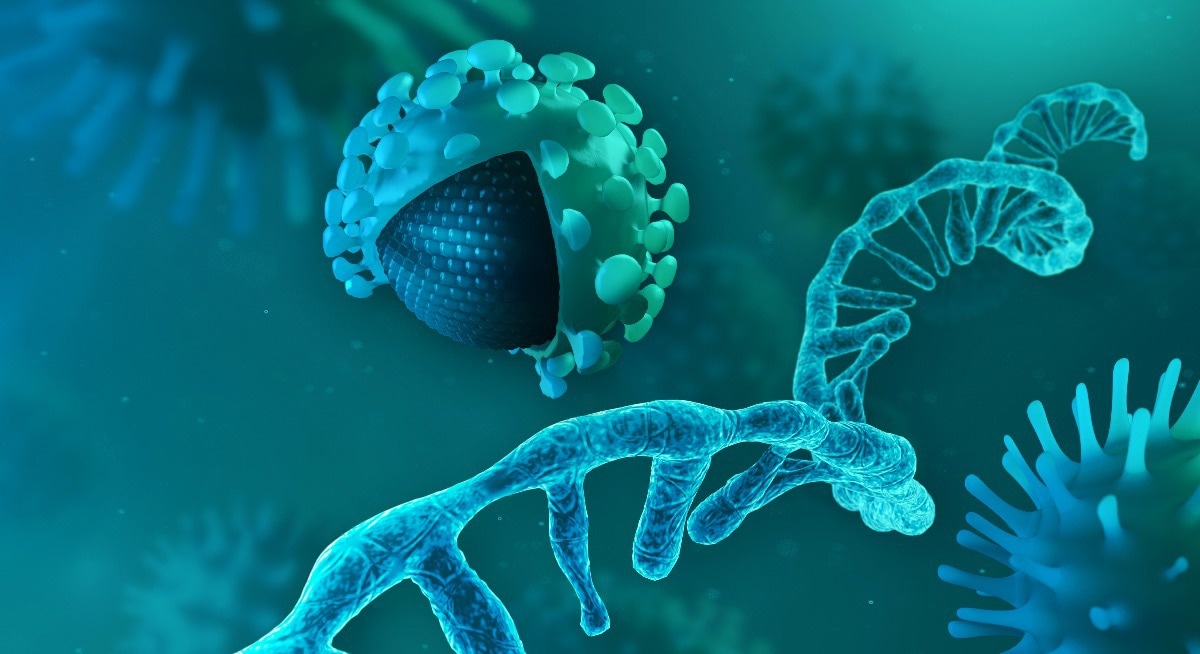In a recent study published in Frontiers in Microbiology, researchers developed RK-33, a small molecule inhibitor of DDX3, and evaluated its efficacy against severe acute respiratory syndrome coronavirus 2 (SARS-CoV-2) variants of concern (VOCs).

The continual emergence of SARS-CoV-2 VOCs has led to increased coronavirus disease 2019 (COVID-19) cases globally, despite the efficacy of COVID-19 vaccines. The emerging VOCs have higher transmissibility and immune-evasiveness than previous VOCs, warranting the need to develop anti-SARS-CoV-2 agents to widen the therapeutic landscape of COVID-19 and reduce the burden of COVID-19.
Host proteins essential for SARS-CoV-2 replication could be targeted to develop novel drugs as alternative or adjunctive strategies to vaccines. Studies have reported that DDX3 is required by SARS-CoV-2 for virion production and is part of the SARS-CoV-2 interactome. Therefore, molecules that inhibit DDX3 could potentially be effective against SARS-CoV-2.
About the study
In the present study, researchers evaluated the anti-SARS-CoV-2 efficacy of RK-33.
Calu-3 (lung cancer cell line) cells were used with non-toxic doses of RK-33 for cell culture experiments and SARS-CoV-2 isolates such as the A Lineage (reference), B Lineage, Beta VOC, Alpha VOC and, Delta VOC were used for the assays. Cell viability analysis was performed, and the 50% cytotoxic concentration (CC50) values were determined.
Plaque assays were performed to assess viral titers, and the median effective concentration (EC50) values were determined. SARS-CoV-2 RNA extracted from SARS-CoV-2-containing cell lysates was subjected to ribonucleic acid (RNA) sequencing (RNA-seq) analysis. In addition, SARS-CoV-2 RNA-dependent RNA polymerase (RdRp) and envelope (E) genes were amplified from RNA by quantitative reverse transcription-polymerase chain reaction (RT-qPCR) analysis to evaluate copy numbers, and proteomic analysis was performed.
Protein sequences for SARS-CoV-2 proteins (n=25) were extracted from SARS-CoV-2 isolates’ genome sequences, and for every protein, a multiple sequence alignment (MSA) analysis was performed. Differences concerning lineage A were noted, and the proteins’ evolutionary distances were assessed. The team obtained three-dimensional (3D) models of A lineage spike (S) protein trimers in closed and open conformations with protein sequences similar to that of the A lineage used in the present study and visualized Alpha VOC, Beta VOC, and Delta VOC variations on the 3D structures.
Results
Targeting DDX3 with RK-33 reduced viral loads of the lineage A, B lineage B Alpha, Beta, and Delta SARS-CoV-2 isolates by one log to three logs in Calu-3 cells. In addition, RK-33 treatment reduced intracellular SARS-CoV-2 RNA production by 2.5 to 3.0 log10, as shown by RT-qPCR analysis. The findings indicated that RK-33 showed potent anti-SARS-CoV-2 effects against all tested viral isolates.
Further, proteomic and RNA-seq analyses indicated that RK-33 downregulated most of the SARS-CoV-2 genes [S, E, membrane (M), nucleocapsid (N), open reading frames (ORFs)1ab, 3a,7a, 7b, 8, and 10]. Furthermore, RK-33 reduced transmembrane serine protease 2 (TMPRSS2) expression by 50% within two days, possibly due to DDX3’s ability to unwind G-quadruplex structures that are present in TMPRSS2.
All the samples comprised 45 million reads; however, MSA analysis indicated that viral-infected Calu-3 cells showed 33% unique human genome matches compared to the other samples (88%). This was a critical finding since the non-structural protein 1 (Nsp1) degenerates host cell RNA to enable the hijacking of host cells by SARS-CoV-2. The reversion of SARS-CoV-2 RNA into host cell RNA among RK-33-treated and SARS-CoV-2-infected cells highlighted the importance of RK-33 for DDX3 targeting.
The majority of the SARS-CoV-2 proteins (P0DTC3 ORF3a, P0DTC2 S, P0DTC9 N, P0DTC5 M, P0DTD1 replicase polyprotein 1ab, P0DTC8 ORF8, aP59595 N and P0DTD2 ORF9b) showed significant upregulation (>7.5 FC) in Calu-3 cells post-SARS-CoV-2 infection and significant downregulation post-RK-33 therapy.
The top five significantly enriched mechanisms post-SARS-CoV-2 infections are (i) interferon-alpha/beta (IFN α/β signaling, (ii) IFN-stimulated gene 15 (ISG15) antiviral mechanisms, (iii) SARS-CoV-2 mRNA translation, (iv) signal recognition particle (SRP)-dependent targeting of co-translational proteins to membranes, and (v) elongation of peptide chains.
Post-RK-33 therapy, a shift was observed in impacted pathways, with the top five significantly enriched mechanisms being (i) mitochondrial (mt) translation initiation, (ii) mt translational elongation, (iii) mt translational termination, (iv) antigen presentation [including folding, assembling, and major histocompatibility complex (MHC) class I loading], and (v) SRP-dependent targeting of co-translational proteins to the membrane.
On querying the STRING database, the team found that certain mechanisms among RK-33-treated cells were enriched positively (endosomal/vacuolar pathways and complement cascade regulation). On the contrary, certain pathways were enriched negatively (mt translation and initiation of mt translation). The findings indicated that the small molecular inhibitor suppressed SARS-CoV-2 protein production, and the changes corresponded to host proteome changes, particularly concerning innate immunological pathways.
Further, 1μM of RK-33 reduced human coronavirus (HCoV)-OC43 titers by >2 logs or >100-fold. The established CC50 and EC50 values among Calu-3 cells were 13.5 μM and < 1μM, resulting in a selectivity index (CC50/ EC50) of 14.5.
Overall, the study findings showed that RK-33 could be used as an effective anti-SARS-CoV-2 therapeutic agent to eliminate host DDX3 functions and curtail transmission of novel SARS-CoV-2 VOCs.
- Vesuna F, Akhrymuk I, Smith A, Winnard PT Jr, Lin S-C, Panny L, Scharpf R, Kehn-Hall K and Raman V. (2022). RK-33, a small molecule inhibitor of host RNA helicase DDX3, suppresses multiple variants of SARS-CoV-2. Frontiers in Microbiology. doi: 10.3389/fmicb.2022.959577 https://www.frontiersin.org/articles/10.3389/fmicb.2022.959577/full
Posted in: Medical Science News | Medical Research News | Medical Condition News | Disease/Infection News
Tags: Antigen, Cancer, Cell, Cell Culture, Cell Line, Coronavirus, Coronavirus Disease COVID-19, covid-19, Drugs, Efficacy, Gene, Genes, Genome, Helicase, Interactome, Interferon, Intracellular, Lung Cancer, Membrane, Microbiology, Molecule, Polymerase, Polymerase Chain Reaction, Protein, Proteome, Respiratory, Ribonucleic Acid, RNA, SARS, SARS-CoV-2, Serine, Severe Acute Respiratory, Severe Acute Respiratory Syndrome, Structural Protein, Syndrome, Transcription, Translation

Written by
Pooja Toshniwal Paharia
Dr. based clinical-radiological diagnosis and management of oral lesions and conditions and associated maxillofacial disorders.
Source: Read Full Article